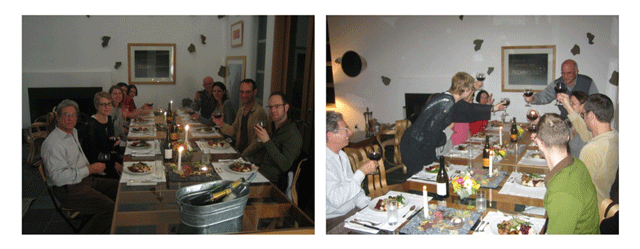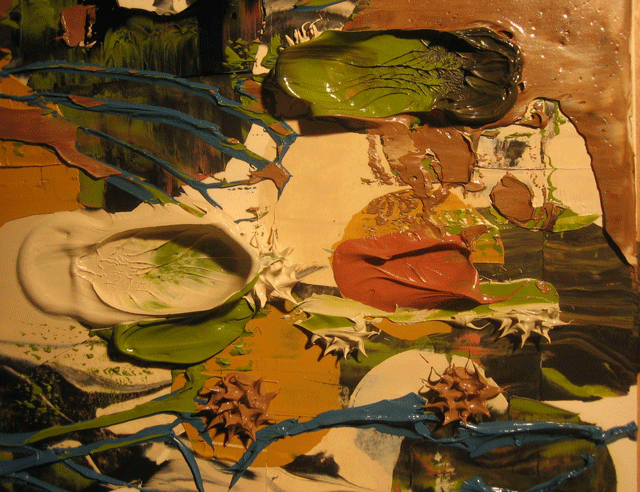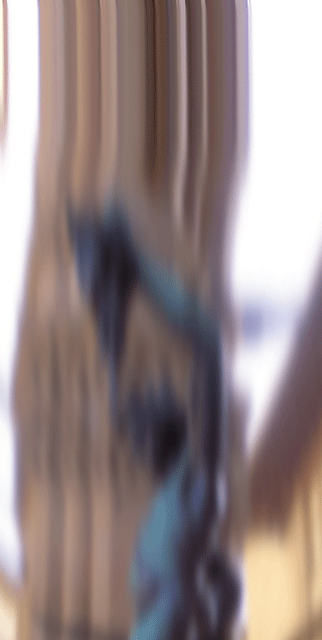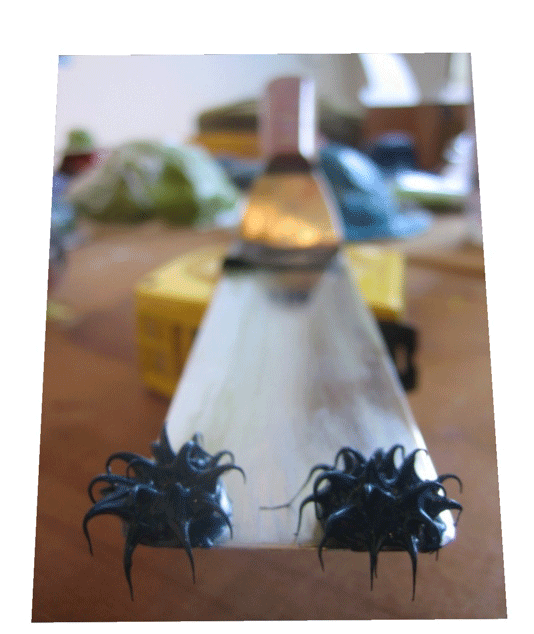November 30, 2006
Baghdad Update
...Terrorists and militias started an open war; the battlefield is our city and the fuel is innocent civilians as always since those criminal groups find it easier to kill civilians than to confront each other (and rid us of their evil). The big problem is that the security forces are not strong enough to stop them, worse than that, some members of these forces let themselves become partners to the criminals.We had no choice but to rely on ourselves to protect our homes and neighborhood insurgents and militias alike. In our mixed block the elders met to assign duties and make plans in case things go wrong. They decided that people should all exchange cell-phone numbers as the fastest means to communicate at times of action, it was also decided that if someone calls to report an attack on his home, everyone else must go up to the roof and start shooting at the direction of the assailants.
More roadblocks were erected and older ones strengthened?streets and alleys were blocked in any possible way to prevent any attack with vehicles.
They also agreed that no one moves on the streets after a certain hour at night and any moving person would be dealt with as a threat.The situation was terrifying and the rattle of machineguns broke through the tense quiet of the night several times every night but perhaps the star of the latest show was the mortar?there has been a frenzy of mortar fire, gladly none struck our neighborhood but we could hear the stupid death packages pass by each other in the air across our neighborhood.
No major incidents happened near us except some shooting at a stranger vehicle which neighbors told me carried militants who were trying to launch mortar rounds from an abandoned space but were forced to run away by the shooting...
Ahora
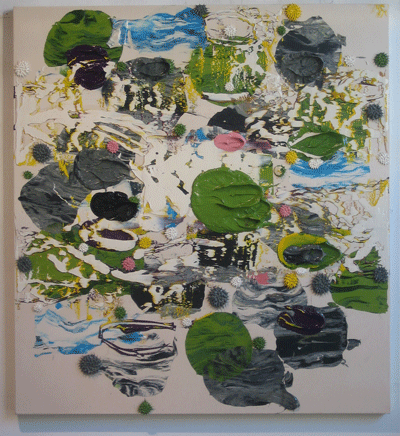
In way, this is a finger exercise for the big painting to come. Fluidity, movement. There's a big potential in the dropped grey masses to hold their own space, a chance I'll get with the bigger painting.

The four big panels (8'x16' in 4 panels) have been delivered this morning. The month of december will be devoted to prepping them (sizing the surface with matt resin, bolting them together and figuring out a rig to hoist them back and forth horizontally/vertically with some semblance of ease (whilst painting works on paper along the way).
As always, the combination of distant and close(er) up is the best way to see the work online. A larger image after the jump...

November 29, 2006
Admin: Dagnabit
It started wiith a crackle and some flutter in the screen. I thought it was funny and I hoped it might be a minor flub in the system, whistler in the dark that I am. Then the screen froze. A hard shutdown and a pause and a push of hte button to start up the laptop and perhaps twenty times later, I finally took my 11 month old laptop to the Apple Store to get the diagnosis: the Logic Board is fried. A week to ten days and all of the information the past 11 months will be gone, this as I was shopping for backup hard drives this week.
Roll with the punches, Dennis. No problem. I'll just reconstruct as much as I can, I told myself. There's a silver lining in there somewhere. Maybe my file system will now be sleeker, more systematic, menos fat.
Then, as I was painting (pics to come soon), I would flash from time to time on things I lost... bookmarks... ouch... painting files... damn... emails... damn... address book... ugh... calendar... well... summer and spring fotos... ouch... 48 songs squandered at the iTunes Store... dear G-d... all those blogposts that escaped post-time that I was holding for later... GRRRRrrrrrRRRrrrr...
At least there is an "archive" in this blog.
...maybe it's time to figure out how to really archive the blog, as in burn and record it in several media?
The strange thiing is...
The logic board was fried last time too!
There's twothreefour possibilities.
LOW: That I use too many applications at once.
HIGH: Catalan electricity has spikes in it when thunderstorms would come in the rainly season in October/November and March/April, the demise of the iBook last January. And then this summer, we had surprise thunderstorms all August and merely unplugging it when I saw lighting wasn't enough. But why the multi-month delay of fry time.FANTASYLAND: It was a coincidence.
MOST LIKELY: It's a message from on high. Chill out. Don't move so fast. You gotta make the mornin' last.
(These waves of irritable discomfort, the lust for news/information, annoyance and slight nauseous annoyance due to the disconnection from the web... would you... call that... net addiction?)
November 27, 2006
How does structure fill space?
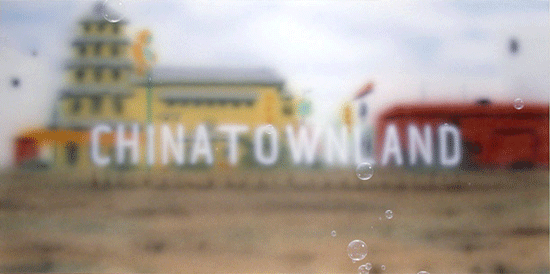
When I read this:
" a world first analysis in inelastic cross-section buckling was undertaken using key techniques developed by Arup. The final tender solution adopted compact sections, which allowed plastic ductility to be taken advantage of under level three seismic loading.",I knew I had to blog it.
Clicking along the way, I recalled a good conversation I had with Todd Hebert Thanksgiving night at Jean Milant's fine house. He had a painting in the room, one of a snowman and bubbles. I can relate to the sandwiching of background and foreground images and the contrast of paint control required to pull it off, the gravitational range, the conceptual connection between the images in each layer.
I was checking out the new Beijing's new "Water Cube" by ARUP Projects. Click here and navigate around. I'll excerpt the whole of the structure page because I just have to:
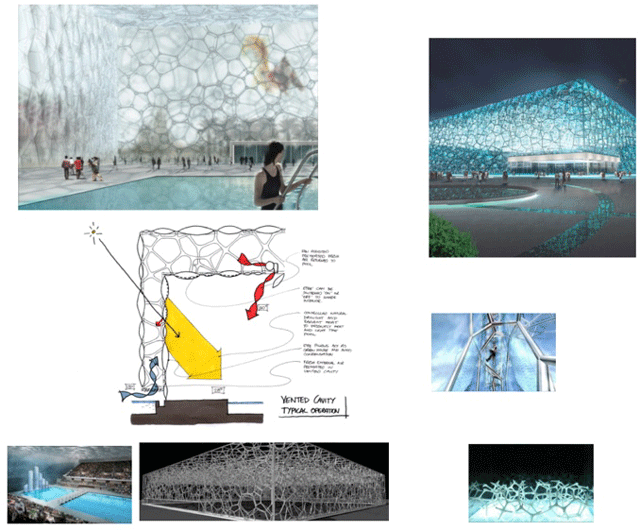
A New Beginning in Design ThinkingPretty Cool. But I hoped that they could have dropped the rectilinear and went for something like this or this. (I was shooting for an image of a handfull of bubbles, bu no luck. --Popup source and source.)The National Swimming Center in Beijing marks a new beginning in design thinking. This new thinking has been spurned on by one question: ?How does structure fill space??
A close up of the Water Cube's innovative steel structure
The structure of the Water Cube is based on the most effective sub-division of three-dimensional space - the fundamental arrangement of organic cells and the natural formation of soap bubbles. It will be clad in ETFE foil cushions which have excellent insulation properties and will create a greenhouse effect.Arup based the structural design on Weaire and Phelan?s (Irish Professors of Physics at Trinity College) proposed solution to the problem of ?What shape would soap bubbles in a continuous array of soap bubbles be?? This problem was both initially posed and tentatively answered by Lord Kelvin at the end of the 18th century but it was 100 years before the Irish Professors proposed a better one.
How the Structure Developed ? Key Considerations
The structure
The wall cavity is 3.6m deep and the cavity forming the roof is 7.2m deep
The structure is made of approximately 6500 tonnes of steel
There are 22,000 steel members and 12,000 nodes
The steel beams would stretch for 90kms
The structure of the building is so strong that it can be stood up on its end and retains its shape
The overall size will be 177x177x31m
An ambitious project, one of the first problems was designing a 22 000 beam structure for 190 loading conditions, where every single beam needed to be as small as possible to minimise steel tonnage. The need to minimize steel tonnage is because in long span roof structures, self-weight is critical.The roof spends a lot of its strength simply holding itself up.
Another challenge was the need to fulfill all of the seismic design requirements of Beijing. The key question is whether to design the roof with compact sections to behave plastically under seismic loads, or whether to use stiffened slender sections to behave elastically under the loads.
To determine which system to use, a world first analysis in inelastic cross-section buckling was undertaken using key techniques developed by Arup. The final tender solution adopted compact sections, which allowed plastic ductility to be taken advantage of under level three seismic loading.
As a coda, here's something interesting at the end of the technology page:
CAD package ? conversion program:That's great news. I've always thought that CAD drawings merely aped the hand drawing process and that this should be superceded by building a virtual 3-D model --my favorite is SketchUp--, one can derive plans, sections and details, an infinite set. Perhaps someday the conversion program will be a standard feature in all 3D modeling programs?
To guarantee that all the elements within the structural analysis model were imported correctly to the 3D CAD model, Arup created a conversion program run from within our CAD package. The program modeled the entire structure in 25 minutes rather than months. From that fully coordinated 3D CAD model, we were able to extract all of our elevations, sections and details to produce our final documentation drawings.
Three dimensional wire frame models were then made and saved to 3D AutoCAD electronic models. This allowed the client and potential contractors to see every object within the building with its relevant information.And then scale models at the push of a button? ?Que bien!
Jet packs, a world free of want and 400 year life spans aren't far off at all.
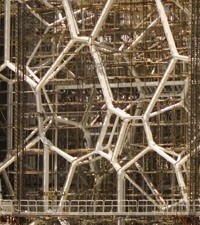
November 24, 2006
Welcome Robot Overlords

Here's an interesting news item: "NYPD Installs "Sky Watch" In Harlem Neighborhood".
It's a short article chock full of interesting aspects and ramifications.
Think about what will happen when machines one day replace the human sentinel.
(Image: Robot arms added.)
November 22, 2006
Asymptotic Symptoms
Would there be any implications of this?
What have scientists discovered today?Fascinating for the evidence of a significant pattern in nature, us:They have found that each of us is more different genetically than we previously believed. Instead of being 99.9 per cent identical, it may turn out to be more like 99 per cent identical - enough of a difference to explain many variations in human traits. Instead of having just two copies of every gene - one from each parent - we have some genes that are multiplied several times. Furthermore these "multiple copy numbers" differ from one person to another, which could explain human physical and even mental variation.
Until now it was assumed that the human genome, or "book of life", is largely the same for everyone, save for a few spelling differences in some of the words. Instead, the findings suggest that the book contains entire sentences, paragraphs or even whole pages that are repeated any number of times.What does it mean, a pattern that is composed of a theme within it's organization, but also staccatto repititions that define an individual?... but also staccatto repititions that define an individual?... but also staccatto repititions that define an individual?... but also staccatto repititions that define an individual?... but also staccatto repititions that define an individual?... but also staccatto repititions that define an individual?... but also staccatto repititions that define an individual?... but also staccatto repititions that define an individual?... but also staccatto repititions that define an individual?... but also staccatto repititions that define an individual?... but also staccatto repititions that define an individual?... but also staccatto repititions that define an individual?... but also staccatto repititions that define an individual?...Woah. How intereseting. An organic entity whose integrity is corroded by stacked redundant information.The findings mean that instead of humanity being 99.9 per cent identical, as previously believed, we are at least 10 times more different between one another than once thought - which could explain why some people are prone to serious diseases.
"One can no longer consider human traits as resulting primarily from [simple DNA] changes... With all respect to Watson and Crick, many Mendelian and complex traits, as well as sporadic diseases, may indeed result from structural variation of the genome," Professor Lupski said.Tidings of dramatic variation:Deciphering the three billion letters in the sequence of the human genome was once likened to landing on the Moon. Having now arrived, scientists have found the "lunar landscape" of the genome is very different from what they expected.
"One of the real surprises of these results was just how much of our DNA varies in copy number. We estimate this to be at least 12 per cent of the genome - that has never been shown before," Dr Hurles said. Scientists have detected variation in the "copy number" of genes in some individuals before but the sheer scale of the variation now being discovered is dramatic.
The Pro Practice Class

My old friend, artist Craig Cree Stone asked me to sit in on his class at Cal State Long Beach last week and talk about what kind of art world his students could expect to work in when they graduate. Craig is a wonderful friend and an excellent artist who has devoted himself to his community, his teaching, his family and the American Indian community (sorry if I mangle the name and terminology, Craig is highly involved in intricately communitarian Pow Wows that occur here annually). An accomplished sculptor, he has garnered several art in public places projects over the years. Other artists out there in blogland should know that Craig is no slacker when it comes to the theoretical arena, either. He's great to talk to because he always brings detail and nuance to the conversation, often leading to a widened reading list afterward.
I arrived early enough to catch a performance by Guillermo G?mez-Pe?a, Craig was helping him set up, with his daughter Lauren in the control booth. A born actor, Pe?a has a remarkable voice, deep and resonant. When I walked in , he was in make-up, eyes in eye shadow and brows drawn archly ready for his eyes to cast downward on his audience. He was in the glory of his Hispa?ola universe, language laced with slang and his performance was to a packed house to whom he communicated in a comfortable and intimate way. Someone murmured next to me as the performance started that the students are about to have their assumptions questioned... but what I saw was nothing of the sort, but rather it was an old time preach to the choir. It was fine and good in that the school was slow to change, given that there were little or no representation by hispanic artists within the ranks of the 50 or so tenured faculty in the art department... but in relation to society at large, Pe?a's performance is a reflection of a bygone social revolution that meant so much more back in the 80's.
After the roaring applause, we took off for a quick dinner before class started and on the way back we stopped by my parked rental car, a Jeep mini-SUV so that I could retrieve the projector in case we needed it in class. Standing precariously on a curb next the passenger side door, I pulled perhaps too forcefully on the door --the top corner smacked me between the eyes. Damn, I thought... I might have to give a talk with a lump on my head. As I jumped back into Craig's car, I pressed my hand on my head and took a look: a streak of blood as long as my palm. I've heard that head wounds bleed a lot, and so it did. I found a handkerchief in my backpack to apply pressure on the wound. Craig's wife was driving and the two of them in the front seat were marveling at the event, "Are you alright? Are you alright?", wondering what to do. Holding pressure against the wound, I remembered another head injury in Tossa years ago (what is this, an emergent theme called head injury?) and Kiko's urge to forge on and maintain a calm public face.
"Nah. No problem. It'll be alright."
The handkerchief was getting soaked. I wondered if I could get the blood flow to stop in time for the talk. In the bathroom outside of class, I handed Craig the camera to document my face as I flashed my best "I'm gonna get you look". I managed to stop the bleed, but I didn't know if it would flow again in class. Then I had a fleeting thought of giving the talk like a Shiite with blood streaming down my face, spraying bright droplets while I describe the art world, my white t-shirt blushing red.
Just a thought.
And then I met the class. It was time to get the game face on.
(NOTE: What follows is essentially a BLOGPOST IN PROGRESS, a one man Wiki. This shall be a post hoc outline recalling what I had said to Craig's class that night. I will fill in as best I can in the following days during the Thanksgiving Holiday and beyond. Sometimes writing can be like chopping wood and sometimes the best one can do is bend twigs along the way as you run into the forest.)

My first thought for these students was: a professional practice class for art students?
I'm used to this curricular provision in architecture school, but in art school? I asked my friends, fellow artists who made it out of school around 2000. CalArts, S.F. Art Institute. Not even then was there such a curricular offering. It's not like there is something wrong with the impulse to inform the students of the sobering reality of the business aspect that comprises the artworld, indeed schools are obliged to ready the young artist for the rigors of the marketplace. The trouble is, there are few people who know what's up out on the street --many of them out in the street themselves, much less those in academia.
When I was a student many moons ago, the old idea of pro practice was a seminar session in which the precious information was tendered, such as: be sure to sign the guest book at the gallery reception desk, study the list of represented artists and estimate whether you fit in or not... then go to the openings and network, take slides and transparencies and disseminate a slide sheet to your targeted galleries... The seminar was quaint like pilots in biplanes dropping bombs by hand in the first world war. Now we are living in a time when the MQ-1Predator can drop a Hellfire missile on a bad guy in the MidEast, directed by a "pilot" operating remotely from a trailer parked at Nellis Air Force Base outside of Las Vegas. Similarly, our artworld today is different in many ways, complex in many dimensions.
In a word, it's bigger.
The soul of art.
In the midst of all this, I therefore propose that there is one issue that is indispensable: something core or essential to art. Let's call it a soul. Students and young artists scare me when they dwell solely on the success engine of the artworld. I ask them: "What are you curious about? What excites you?" And older artists who think like this are tragically boring. Don't forget the art-part as you prepare to engage the would be Leviathan of a professional, industrial, multilayered, interconnected, hyper attenuated, 21st century artworld.
Intrinsic/Extrinsic
The interesting aspect of art in economic terms is that great art exists outside of those terms. The greater the remove, the greater the art. Great art is priceless, as everyone knows and all other candidates for that nomination have the ambition to be priceless. Art is art when someone invests in material/thought/activity for it's own sake. The object/subject/project goes into the world charged with a value that has an intrinsic nature. Less intrisic value, less extrinsic value. More intrinsic value, more extrinsic value... when finally others understand what's going on in there.
Be the first audience
If the artist is not the first audience, there will never be others of lasting consequence.
The mission from G-d, doing that for which you are put on this earth to do, that there is something transcendental in the intrinsic/extrinsic twist of irony:
Matt Murphy: But babes, this is Jake and Elwood. The Blues Brothers.Whether you are indeed religious or secular or somewhere in between, finding a drive that isn't merely self indulgent might be a good thing. Having some idea or notion or hunch whose source is outside of your ego, that drives you beyond your natural state of repose, that tasks you and changes you and forces you to struggle as if you life depends on it... this, I consider the very definition of art in the widest sense.
Mrs. Murphy: The Blues Brothers? Shiiit! They still owe you money, fool. You're livin' with me now. You ain't goin' back out on the road and playin' them old two-bit sleazy dives, and y'ain't gonna go slidin' around witcho ol' white hoodlum friends.
Jake: Ma'am, would it make you feel any better if we told you that what we're asking Matthew to do is a holy thing?
Elwood: We're on a mission from God.
Mrs. Murphy: Don't you blaspheme in here! Don't you blaspheme in here! This is my man, this is my restaurant, and you two are gonna turn around and walk right out of here - without your dry white toast, without your four fried chickens, and without Matt 'Guitar' Murphy!
why is today's artworld especially problematic?
-Scale: the artworld is huge and getting bigger.
It takes some effort for those of us who were kids in the 60's to remember just how small the world was then. Am I correct in stating that the artworld of New York in the 50's could have fit in the Cedar Tavern? Correct or not, our artworld has since then exploded in population and structure. In Los Angeles alone, there are eight art schools that I can count off hand. Every year they graduate scores of young artists some of whom are starting their own galleries or working for the institutions museum, school or otherwise.
Is it possible that the dimensions of the artworld made sense in terms of equilibrium, proportion and balance back in the 50's and 60's... perhaps the 70's? And now in terms of the sheer number of artists and the objects/subjects/projects they produce are too big for the number of museums at large to cope their mission of telling the story of art both recent and breaking.
Here in Los Angeles, one can see the old guard artists dutifully making their rounds, checking out the shows in the city. Impressive, since many younger artists have since given up on trying to see it all. Even so, it has been a while since I have heard of sightings of the venerable John Baldessari, making his rounds here in ChinaTown, the last of the comprehnsive scene checkers. After a while, it becomes inevitable that some shows pass you by... if you are interested in getting some work done in the studio. Rachel Cooke commented on this in the Guardian recently:
I've been worrying about the quality of my looking. Last month, I went to see the new Hockney show at the National Portrait Gallery. I love Hockney and yet, coming out, it was a surprise to look at my watch and realise that I'd devoted only an hour of my Saturday to him; it had felt like much longer. Then there was my immediate and unthinking purchase of a catalogue. I must have a catalogue: it's my way of owning what I've seen - and a kind of proof that I was there at all. For while I see everything I can in terms of hot tickets, it would be equally fair to say that, often, I see absolutely nothing at all. I walk round galleries in a kind of dull stupor. Three weeks later and, from memory, I can only describe, at most, six works from the Hockney show - and none of those very well. There are good reasons for the gallery visitor's failure to see. The blockbuster shows, assuming that you can get into them at all, are crowded beyond all endurance. Between 3,000 and 4,000 people see the 45 paintings that make up the Velazquez exhibition at the National Gallery every day (in the month since it has been open, it has attracted more than 86,000 visitors). Exhibitions like this are also loaded with an inhibiting once-in-a-lifetime significance. Completism paralyses even as it excites: desperate not to miss anything, you fail to stand in front of any one thing for more than a minute. But it's more than that. We live in a culture that is so image-heavy, it has resulted in a kind of collective blindness. Once, it must have been possible to have stood in front of a great painting and to have felt your world being slowly flooded as if by some wondrous light. Now, it is possible to stand in front of a great painting and to feel nothing more than: yeah, I've got the postcard.Then she polishes the essay off sharply:
But in the 21st-century gallery, with its shops, its cafes and its crowds, it feels like an act of stubborn resistance just to sit there, and to look.
Art prices have soared into atmospheres of thinning air. The Financial Times' Deborah Brewster recently reported the record sales in the auction houses, "Record art prices astonish New York dealers":
More than $1.3bn in works of art have been sold in the past two weeks during a record New York auction season that has pushed art prices to an all-time high. Experienced dealers and collectors were astonished by some of the prices paid at auctions held by Sotheby?s, Christie?s and Phillips, which pulled in twice the sum they did last year. The worldwide collecting boom shows no sign of slowing, with Russian, Asian and Middle Eastern collectors, along with hedge fund managers, providing a fresh pool of buyers.
Then there's the phenomena of the recent aggressive museum expansion that has sprouted worldwide. I Google to an article by Dan L. Monroe writing for the Art Museum Network News:
The "Age of Expansion" marks an unprecedented period of growth among the nation's art museums. Roughly encompassing the period between 1995 and 2010, the Age of Expansion has witnessed the creation of new facilities at museums large and small. Designing and constructing these facilities, creating new installations of collections, and raising large amounts of money have consumed the time and energy of art museum directors, staff, and trustees. As a result of these efforts, the status and role of art museums in America has forever changed.Which is all fine and good. I as an artist should recieve such news with a smile... and I do... but there is in fact a darker aspect to it --the eventual morphing of the educational mission of the museum into the profit drive of the commercial gallery:Yet remarkably little attention has been given to thinking about the outcomes we may expect from the Age of Expansion. Few among us have had time to consider the possible long-term consequences of the prodigious collective effort that has been made.
And so another museum goes to market. Last week Buffalo's Albright-Knox Art Gallery announced it plans to sell some 200 objects from its permanent collection......But the issue is bigger than the nostalgia of a single museumgoer or the history of one city. It's a problem that's become endemic to the profession. Museums are devoting more and more resources to acquiring large amounts of contemporary art, work about which the judgment of history--supposedly what museums are all about--is far from settled. Such acquisition policies may be acceptable, but not when done by getting rid of masterpieces whose importance has been validated by time and critical opinion and that provide a context for the work of the present. Ironically, this plan is driven by perceptions about the notably erratic and currently inflated contemporary art market, rather than by any dire financial crisis.
The museum maintains that these disposals follow the policies of the Association of Art Museum Directors, which allow museums to sell in order to buy. If so, then perhaps it's time to revisit those policies, rather than taking for granted that trading art for art, whatever the merits of the work, is acceptable. (Disclosure: I am an AAMD emeritus member.)
It's not comforting to think that a "special advisory committee" of fellow museum directors was invited to assist in what Mr. Grachos calls the "careful vetting process" that produced the list. Museum folks are notorious for covering up each others' missteps: Just watch the constant buying and selling that characterizes what used to be called "collecting" but that has now obliterated whatever lines once differentiated the roles of curator and dealer. Richard Armstrong, director of Pittsburgh's Carnegie Museum and a member of the Albright's committee, suggested that the process was made in an "elegant and open way that sets a national standard." Do we really want this kind of national standard that robs communities of their assets?
Then two days later in the same WSJ's Opinion Journal featured a piece about the same museum. Eric Gibson wrote:
...museum officials claim they can build their collections only through tax-incentivized donations. ?[I]n today?s art market, museums cannot realistically expect to have the funds to purchase such major works on a regular basis,? Mr. Cuno writes.In the passage of Newtonian to Einsteinian physics, one encounters Alice in Wonderland phenomena, such as charmed quarks and Schr?dinger's Cat and non-locality and a menagerie of oddities, a journey into the subatomic realm. But what of all the role shifting as we dilate the artworld out of the scale of human experience and into the 21st century? Just what kind of artworld wonderlnad are we growing into?Er, not quite. They have other ways of doing so, like selling works they already own. Just last week the Albright-Knox Art Gallery in Buffalo, N.Y., announced that it was selling more than 200 objects from its collection to raise $15 million for the purchase of modern and contemporary art. ?Deaccessioning,? as the practice is known, used to be the tool of last resort for acquiring new art. But lately it?s become the tool of first resort, with museums strip-mining their collections just to build a war chest. This has caused considerable alarm on the part of many museumgoers, but the directors of these institutions have argued that they are merely adhering to AAMD guidelines, which permit selling art in order to buy it.
In other words, museums are trying to have it both ways: benefiting from tax subventions because they supposedly can?t survive in the marketplace yet stepping into the marketplace when they deem it appropriate. Deaccessioning isn?t the only way museums are increasingly operating as commercial enterprises. They have restaurants and shops, and rent their spaces for gala events. Some are actually renting out parts of their collections. In 2004, the Boston Museum of Fine Arts lent some Impressionist paintings to the for-profit Bellagio Gallery in Las Vegas in exchange for a percentage of the (substantial) gate.
What?s so disturbing about collection rentals and sales is that they violate the reason that museums are treated differently from businesses. Because of their transcendent importance, museum objects occupy a position outside the pressures of the marketplace. Yet more and more museums are treating these objects as financial assets that they can tap at any time. And the two professional bodies charged with oversight responsibility?the AAMD and the American Association of Museums?have been toothless watchdogs.
-Collectivism vs the Marketplace: the entrenchment of socialist models (the overweening and unquestioned dominance of Marxism in academia) has allowed us to blind ourself to market realities in important arenas. Yet paradoxically (perhaps not) we are ultimately stimulated by power, the thought of active participation in the marketplace is discouraged and yet it cna be argued however provocatively that this is sum total of what the artworld is or has become. There is no recognition of where the legitimacy of pricing spawns from (for example Hayeck's theory), this is probably the most siginficant economic issue for art students to understand. The art market exists robustly in a wild west environment. Pirate country like the high seas. Or artworld is unregulated, unpoliced, uncharted by transcendental claims to truth and pocked by countless no man lands of pure seething power relations... a strange world in which everyone in it is apparently too content with or too afraid of the status quo to establish a constructive critique against it...
...plus, the marketplace is evolving...Schimmel's brilliance: three epoch defining curated shows: Helter Skelter, Out of Actions, and Public Offerings, the consequenses of the show: artwork as investment grade stock... the question is whether capitalism is a riptide away from altruism and human values or will those values and core of humanity prevail in other forms that we cannot yet recognize?
if property is theft, then what are we to do with the fact that all artists create property? And what should we do with the implied imperative of restraining or conforming or aligning one's artistic subject with the agenda of the Progessive? world view? If all that is solid is to melt into air, then the postmodern imperative is to dematerialize art into the conceptual realm... the consequence being the the apparent extinction of art itself (the intrinsic value) like the smile of Alice's Cheshire cat (ugh, did the cat extinguish itself?). (The word we can't use in polite artworld company: postmodernism.) The most dematerialized such as LeWitt is doing fine financially. Is Hans Haacke rationing cans of tuna since he apparently disappeared? I suspect Hans is doing fine.
A dealer once said: "It isn't art until it is sold." I don't blame him/them for thinking this way, I might agree if I too were a dealer. The sale of art is the first figuration in the public record. A tree might fall in the forest but only if there were certified data to verify the fall. However I am an artist and my first response is that then such would be a fraud since art must be art (that which is qualified by intrinsic value) before it it is sold, else it's a merely a commodity whose price is soley a measure of extrinsic value and little else. Thus, the irony of commodities which qualify themselves as such by criteria outside of the marketplace.
Surely dealers recognise value and represent the art object/creator as such and therefore are crucial figures in this prime act of recognition. Dealers in this schema become the sole authenticators of value. But such value is ultimately not created but discovered and the truth is somewhere in between, a handshake of the intrisic and extrinsic. The upshot: don't forget the soul whilst you chart the profession, young artist.
-Change: Herodotus, mutations, hybridizations, crossing media
...change in my time: reel to reels to the internet
place shifting
time shifting
role shifting (article on museums becoming banks)( link to camper)
...in education: education as we know it has been minted in the previous eras where a huge chunk of educational curriculum was devoted to instructing students in how to understand and fit in to complex systems of existing organization... now entire industry life cycles can be born and expire in less than a single generation
-Change into what?
(reference to Schimmel again, "Public Offerings" and the conversion of the art object into a stock, a piece of the brand... and therefore the remove of the artist as existentially sensitized human in the heart of the art history drama, (--Car City, the code for the trajectory of our imagination, the distance from coporeality that we are travelling)
Since computers are running all this, the reactions are quicker than with human pilots. The UAVs can perform a number of dangerous missions, like attacking air defenses, searching for targets on the ground, or defending the entire "package" (the manned aircraft and all the UAVs) from enemy aircraft. The UAVs can be used more aggressively, because you are not risking the lives of pilots. If the manned aircraft is shot down, the UAVs have their programmed orders to complete the mission, or immediately break off and return to base.
-anxiety:
structural anxiety
For the artists*: the artworld is like a theater, the wings are crowded with actors (artists) but the stage is small, hence the despair in the diminishing possibility of standing under the spotlights. The sole saving grace: that the marquee has to change.
For the dealer*, where does anxiety stem from?: Contentment or validation can only be found at point of sale, the briefest of momements. For the time before, after, and between sales... skin crawling agony. Why? No one knows what will sell. And if someone on earth did, they would rule the world. Dealers might pretend they know, and they have a better inkling (which is all one needs), but ultimately they won't know until the moment something sells, and then the moment is over. The only truly happy dealers are gallerists too. And who are gallerists? A subset of people who live for the exhibition as a form of expression. Gallerists who aren't dealers, who make money with their efforts, are called museum curators.
If happiness exists fleetingly at the point of sale, then the recent structural change in the artworld provoked b the advent of art fairs has intensfied both happiness and anxiety. Once upon a time, art sales occured in a pattern distributed troughout a calendar year. Collectors have generally reserved their purchases for the art fairs since a convention of art galleries will allow optimum price and selection comparisons. The upshot of this is to concentrate the occurance of sales episodically... and so too have anxiety and temerity (see the last issue in this section below) amplified considerably.
hyperdeveloped... the groundrush effect... freak outs that stem form the distorting effects of the mediated hothouse... the tendency to be hollowed out by envy and desire for popular success
art is in constant movement, towards the landfill or towards the museum, as the first audience, everyone who appreciates art has a responsabililty to guard against the landfill, to move the art you love/appreciate toward the museum.
The lifeboat... It is as if we are all adrift at sea, seemingly alone on a lifeboat and we (as artists) are thirsty for water (a show) and yet there is all this seawater all around us... DON"T DRINK THE WATER... wait for the exhibition opportunity that will thread you in the proper context. You may feel desperate but you have to choke it down. You have to control your fear, not only for your sake but more importantly for those around you.
Sgt. Barnes: Take the pain! Take it!
anxiety and the connection to envy and using the dynamic of the greener pasture. I don't know if I am projecting, but my recollection of David Hickey's writing was that he urged artists to have their own party, and not be overly concerned about joining another
The flip side of anxiety: Temerity. An occupational hazard, narcissism and hubris come with the territory in the creative world. Perhaps it stems from the utility of criticality. In art school, savage (a figurative and relative adjective) critique is instrumental pedagogically. The young artist is encouraged to form comparisons of their work to to that of exemplars (well regarded artists in history) who are enlisted to compose a personal jury whose purpose is to hone our work in the direction of perfection (a figurative and relative noun). And then most of us get out of school and forget the proper arena for the instrumentality of our personal jury. SomeMosttimes we inflict our self flagellatory instruments on others without thinking. We do this together in the public at large, but in a much more diffused and argumentative way. Currently, our shared public exemplars and the design of our devices for flagellation are wide open for dispute.
-recentness: before we can talk about how the art world became a professional place, it's helpful to remember that the idea of art itself is a recent one. For the purpose of this essay., there are three kinds of art: art in the universal creative sense ("the art of ..."), art outside the West (tribalist) and art inside the West (Oedipal)
-Sanity: to throw down a definition of sanity: the ability to maintain the distinction between fantasy (imagination) and reality (the stubborn stuff), art may be viewed as the interdependence and the commerce between the two.
Why care about art anyway?
For the sake of argument, let's say that maybe art as we knew it is a passing phase --quaint and antique and dead and gone-- and this emergent marketplace dealling in cultural products is the the triumphant reality. (Story about museums becoming profit centers) why should anyone undertake the responsibility of moving art towards the museum? What makes art not only legitimate but indispensable for the human condition?
-Freedom, dissent/expression
-Resistance against the dehumanizing trajectory of our inventions, the irony of the tendency of the inhuman consequence of our imaginations, the suicidal aspect of our imagination... that to decouple imagination from reality is an act against life... that our idea of art may be recent, that this current manifestation that we tend to take for granted is a passing one and an eternally changing creative force known now as art is the real and enduring one... that within a blooming (metastasizing, if you feel cynical) industry, a kernel or soul has to be preserved... the industry needs it, we need it, freedom needs it, mankind needs it.
-Life made anew: art is the crucible in which the patterns of life are solidified, encrusted, then busted and reformed anew... make a pattern, break the pattern, then do it again...
-Everybody is a star: a democratic idea of imagination, (the only way to teach art, I believe)

(Sly Stone Image Source)
*Disclaimer: These characterizations are not to be taken literally, but are offerred as a figurative depiction for the structural synamics of how stress germinates and propagates in the artworld. It is not my intention to render an image of weakness other than that which is already inherent in the human condition.
Chinese Guy

I opened my door and there was this Chinese guy. A television show was being shot out front. It was for a TV series called "The Unit". something was to happen within the New Dragon Restaurant and then into the alley with a fight of some kind.
I reached for the camera as I talked. Even though he initially didn't say much, I discovered that the Chinese man spoke english easily. Most of the Chinese neighbors here have a different sense of boundary, they'll poke their head into an open door more often than not. But since those that do are still very Chinese, it's hard to strike up a conversation with them when they do. They usually look blankly and carry on. But this guy was different.
I flipped open the camera as I noticed that there was a flutter in the film crew outside. Film people don't like cameras on the set. It freaks them out because it freaks the actors out, fear of the paparazzi attack and all that. So I ignored them and kept the camera close to focus on the Chinese guy.
Sometimes I half-tease my wife Stephanie that I will sport such fine whiskers when I get old... and the time is growing close. So I asked the Chinese man how long it took for him to grow his distinguished chin hairs. I thought he might dispense some ancient wisdom from the land of jade.
"It's make up, man. Heh. They just put it on."
(He must have grown up in Pacoima.)
It's ChinaTown, Jake.
November 20, 2006
Benvenuto
I know a blogger when I see/read one:LIV
ON that very day, as I was passing through the Piazza Navona, and had my fine retriever with me, just when we came opposite the gate of the Bargello, my dog flew barking loudly inside the door upon a youth, who had been arrested at the suit of a man called Donnino (a goldsmith from Parma, and a former pupil of Caradosso), on the charge of having robbed him. The dog strove so violently to tear the fellow to pieces, that the constables were moved to pity. It so happened that he was pleading his own cause with boldness, and Donnino had not evidence enough to support the accusation; and what was more, one of the corporals of the guard, a Genoese, was a friend of the young man?s father. The upshot was that, what with the dog and with those other circumstances, they were on the point of releasing their prisoner. When I came up, the dog had lost all fear of sword or staves, and was flying once more at the young man; so they told me if I did not call the brute off they would kill him. I held him back as well as I was able; but just then the fellow, in the act of readjusting his cape, let fall some paper packets from the hood, which Donnino recognised as his property. I too recognised a little ring; whereupon I called out. ?This is the thief who broke into my shop and robbed it; and therefore my dog knows him;? then I loosed the dog, who flew again upon the robber. On this the fellow craved for mercy, promising to give back whatever he possessed of mine. When I had secured the dog, he proceeded to restore the gold and silver and the rings which he had stolen from me, and twenty-five crowns in addition. Then he cried once more to me for pity. I told him to make his peace with God, for I should do him neither good nor evil. So I returned to my business; and a few days afterwards, Cesare Macherone, the false coiner, was hanged in the Banchi opposite the Mint; his accomplice was sent to the galleys; the Genoese thief was hanged in the Campo di Fiore, while I remained in better repute as an honest man than I had enjoyed before.
November 19, 2006
November 14, 2006
Cecil's in the House
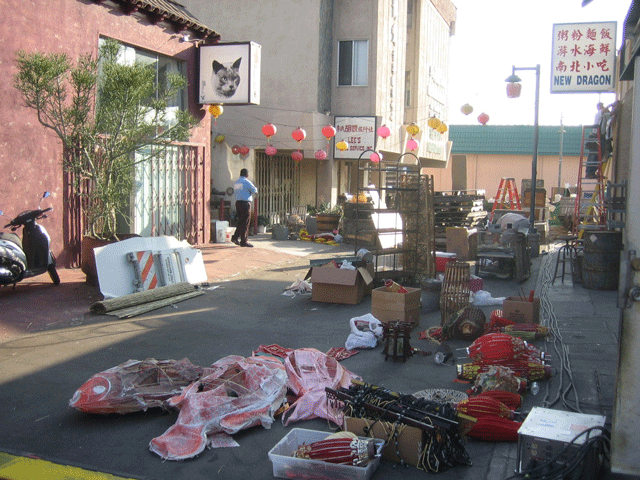
They're shooting a movie out front, something about a TV show about detectives or somesuch. Life in ChinaTown, I now google and wikipedal a bit for context:
The Los Angeles Chinatown saw major development, especially as a tourist attraction, throughout the 1930s with the development of the "Central Plaza", a Hollywoodized version of Shanghai, containing names such as Bamboo Lane, Gin Ling Way and Chung King Road (named after the city of Chongqing in mainland China). Chinatown was designed by Hollywood film set designers and a "Chinese" movie prop was subsequently donated by the legendary film director Cecil B. DeMille to give Chinatown an exotic atmosphere.Well, there it is.
To this day.
We're talking Cecil B. DeMille, people.
Further down, I was pleased to find:
While you're there enjoying great food, you can also visit some of the best gwai lo art galleries in LA. There is currently over 20 galleries to see with great works of art from up and coming artists in all types of media. A great date idea for Saturday nights is the gallery tour from 6-9. Its the day when about a quarter of the galleries opening a new show and there is free beer and drinks to anyone who attends. The most popular galleries are Acuna-Hansen Gallery, Black Dragon Society, China Art Object, and The Gallery at General Lee's.I guess that was written a while ago. I've never contributed to Wikipedia...
Maybe this text could stand some strengthening in the "most popular" category...?
Bloom
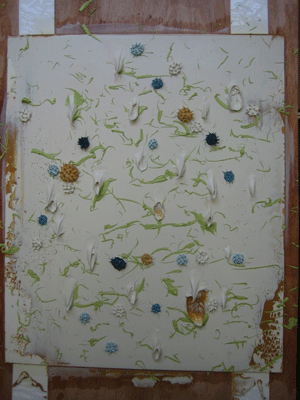
Back farther afield.
Time to wander.
Most times I prefer to see them spotlit.
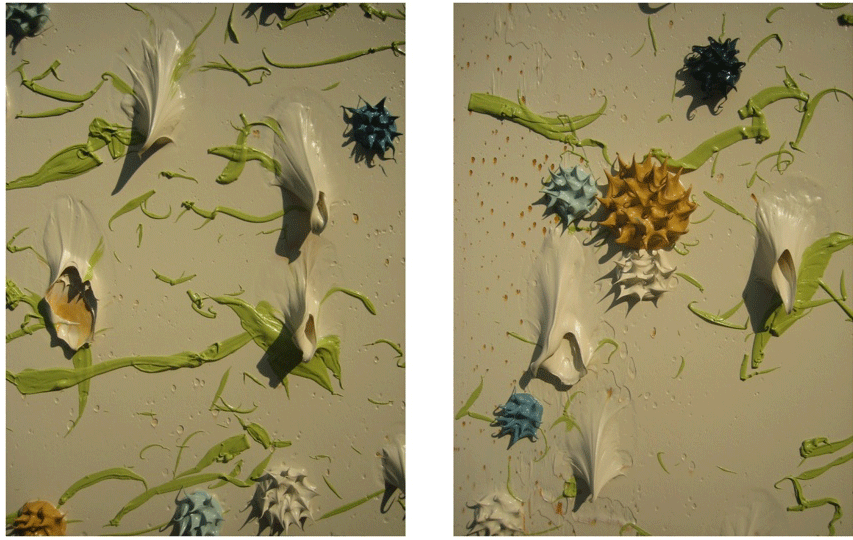
Pucker.
Gemalim
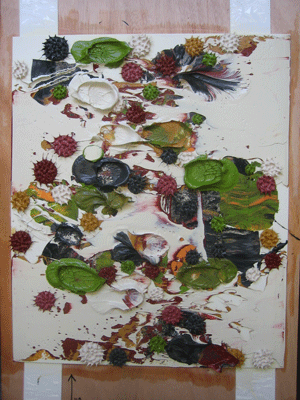
Works on paper.
Get sticky, twitch the muscles.
Move around and clap the hand.
Combine this view with the next one by scrolling up and down, up an down, up and down to simulate the actual experience...
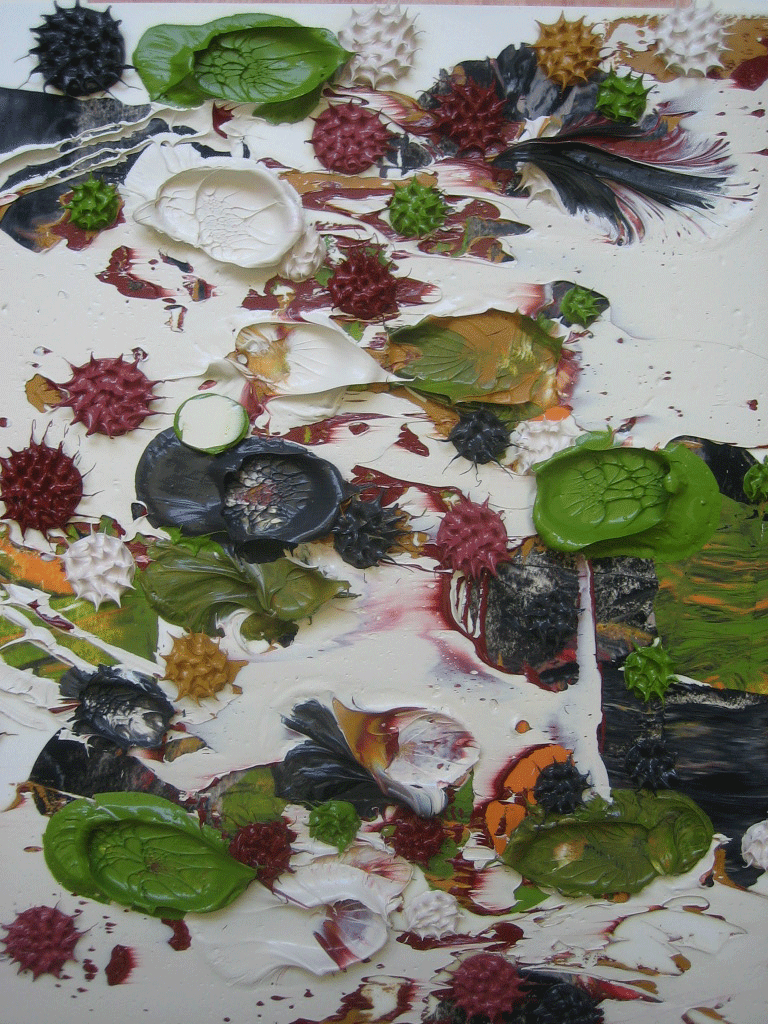
(a Gemalim is the name of the song I had playing at the time, "Is Gewejn A Folk" by Elias, Lutz & Massel Klezmorim.)
November 13, 2006
Tagged

I had a twinge of irritation when I noticed that someone had tagged my studio with a cat image, a print on paper glued onto the blank lightbox.
But after a while, I came to admire it.
Not too bad, as graffito goes.
UPDATE: Stephanie says that the studio looks like a Chinese Veternarian... not a bad idea!
The Bloggable and the Unbloggable
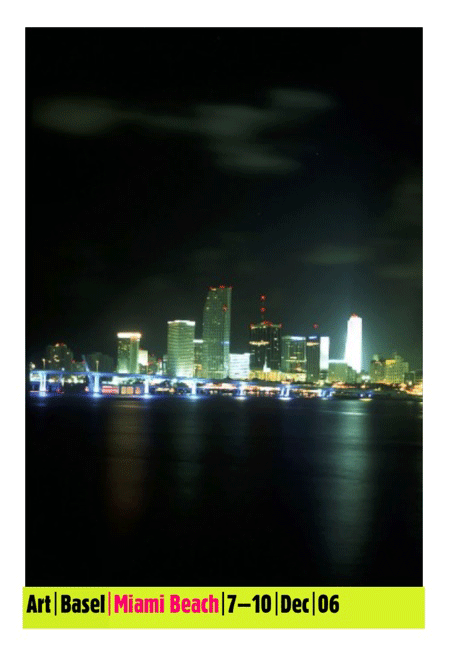
Saturday night was to be a good night just because there wasn't an overwhelming number of art/social events for a typical LA weekend. All that was on the radar was: 1) something about "Paper", a rolling thunder promotional exercise for the benefit of a group of art related magazines. I missed the ChinaTown shmooze night and the gala Hollywood thing for which I had heard that there was a crowd and line watiing to get in the club on Hollywood Boulevard... thank G-d I missed that one. You have to be in your late teens or early twenties to endure that experience. The third event for the Paper promo engine was a Saturday thing that was to be eclipsed by.... 2) The Cirrus opening for "Naive Set Theory", a show curated by Catherine Lord. I wanted to support jean Milant's efforts in hosting shows for young curators and artists, to toast a glass with Jean after the monotypes we created recently and to see if I could extend a furtive conversation I had with Catherine earlier in the week about her curatorial thesis. A soon as I had dismounted my scooter in the Cirrus Parking lot, I patted my pockets only to realize that I had left my camera behind. ?Que Lastima! Jean promised to send me a couple of jpegs of the show, so I should pinch the blogsac about the show until the fotos come in.
But it was quite a night, most of it unbloggable. In Spain, most everything I experience is material for the blog. But here in LA, there is a matrix of confidences and discretion that must be respected --else I destroy many friendships and compromise careers. The crux of the problem is that many, many fascinating art issues are entangled within the personal and business realms. The temptation to tell-all is great. But if you want valor, then you'd best be discrete.
But what can be reported about a night on the town that bounced from the opening at Cirrus then to Hop Louie then to the bar formerly known as the "Score Bar" in downtown LA, then to the "Pantry" for a 3 am eggs over easy breakfast? Well, Mat Chambers and Chris Liponi were hilarious and laid back, and my other two friends were locked in a monumental psycholanalytical take down... and that I was much impressed, inspried and humbled that by the end of the night, they had talked through thier issues and found a new level for their friendship to carry on.... that they would not let their friendship be destoyed by their differences. Highly admirable.
And that's about all that can be said about that right now.
What must be reported however, is the tsunami-like loom of the ArtBasel Miami Beach Art Fair. Several weeks ago, my friends Aaron Parazette and Sharon Englestein called and offered to put us up at their folk's place in Ft. Lauderdale during the fair, why don't we fly over with them? I had been looking for an opportunity to fly across country to Houston with Stephanie to see their new baby girl Joy and talk. And I mean talk. When Aaron and I talk about art, we go deep. It's better with Aaron than the usual chat time in the art world because Aaron is a kind of all terrain vehicle when it comes to the hablaba in our trade. He can go into art theory, hardcore studio practice, personal and personality dynamics, the intricacies of business, politics local to the art world and as geopolitical as it can get, the comedy and the tragedy of it all, as deep or as light as you want, for hours and hours with careful consideration the entire time.
So I happily bought the tickets and rented a car.
Then I began to hear the word on the street. Most everyone I am talking to are going to Art Basel Miami Beach. It's like seeing the beach evacuate into an abnormally low tide before the tsunami break. ArtNet's Walter Robinson reported twelve events, twelve art fairs opening that weekend:
Back in 2001, when the Art Basel crew scheduled its first art fair in the Miami Beach Convention Center, it was clearly an idea whose time had come (even though the events of 9/11 caused the debut of Art Basel Miami Beach to be postponed until 2002). Miami?s balmy weather and party atmosphere, not to mention its role as a gateway to the avid Latin American art market, makes the city a ready destination for contemporary art lovers the world over.(emphasis mine)
Now, the art world knows a good thing when it sees it, and by 2005 Miami was hosting at least four important art fairs in addition to Art Basel Miami Beach -- the immensely successful NADA Fair of hip young dealers, plus the artist-organized Aqua Art Miami, located in Miami Beach hotels, and the new Pulse Miami and Scope Miami, both in the city?s Wynwood Art District.This time around, however, the Miami lineup is giving pause to even the most energetic art lovers. At least 12 different art fairs are scheduled for early December -- and it wouldn?t be a surprise if we?ve overlooked one or two more. Can the art trade actually support so much activity? Will all the rest of the world?s galleries be empty for the week? Only time will tell -- and the time is drawing near.
I think the issue of SCALE and the tendency of the imagination to outstrip our human (hence limited) capacity to digest it will be a rich vein to mine conversationally that weekend.
The tsumani effect is that most everybody I talk to are going to the fair. New York, LA, Tokyo. In addition to the twelve sanctioned official events, there will be several spontaneous happenings crafted by artists sprinkled throughout the weekend. It will be a nightmare of social vectoring and the mysterious powers of quantum dynamics will not be enough to let us appear simultaneously in multiple parties and rendezvous.
I swoon at the thought of it all. Steady yourself, Dennis. Focus on the one important thing for that weekend: bring your bathing suit.
Stay tuned for more of course.
(image courtesy ArtBasel Miami Beach)
November 9, 2006
CIRRUS Monotypes, Signing Day
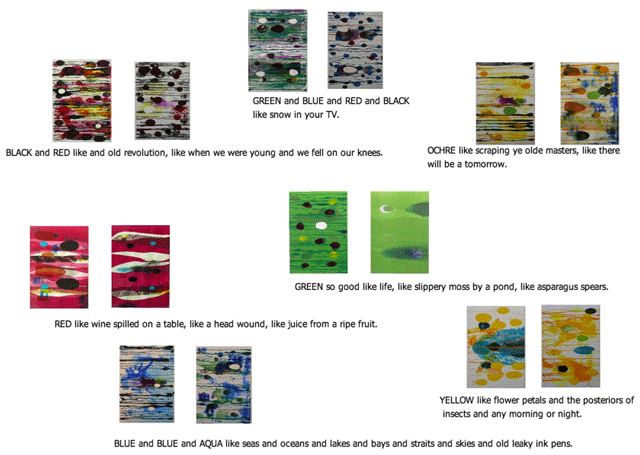
The prints have dried, and Cirrus Editions has cataloged and stamped each of the 98 monotoypes with the classic Cirrus chop (an image of the clouds of course) in the lower left corner of each paper. They followed my direction and compiled the dried prints in piles aggregated by color. Sorting through them all, I tossed away a bunch, maybe twenty or so... a cull of the herd.
The word "cull" is appropriate. At first, Master Printer Francesco Sigueros and assistant Lino and I bantered a bit in Spanish (as best as I could), getting to know one another. Francesco seemed intent to introduce me to the more flavorful parts of his mother tongue and one of the terms he used was "ojete". He would use it when things went wrong, when there is something messed up, when mistakes were made. "Watch out for the ojete, man." "Oh, that's a nasty ojete, terrible!" Since I was looking for inspiration outside the site of artmaking (swaths of paint left on the pallette, accidents, mistakes, even ink that could be blotted off the drum of the print machine, or the dribbles of ink just outside of the frame on the printer's bed, or things that happen when you've exhausted every other tactic and you just act a fool and do something foolish...) I took to calling this series of monotypes "LOS OJETES". Sounded good. By the time I was to leave for Spain this summer, I was happy to have found the animating idea and have a name for it.
In Spain, my friends there found some amusement as to the choice of title I had selected for the monotypes. According to them, the term ojete refers to the anus, and is used for a great many other affiliated ideas and really it isn't satisfactory for mixed company. "So let me get this straight..." I said in poor Spanish, "...an ojete is not a cola..." I made a pantomime of a dog or cat's tail wagging, "...and a culo is not a cola..." I made a representation with my hand in a universal pucker gestrure, "...therefore a culo is an ojete!". That was good for a drink or two.
Alright. OK. Let's see here....
Back stateside and in back in Cirrus to complete the project, I kept my antenna up for another title. Lino was assigned to help me finish the project and in an unassuming moment while listening to my recurring direction towards inspiraton found off the frame, he mentioned black sheep. OVEGAS NEGRAS. That's it. Black sheep, ovejas negras. Monotypes made from the castaways, from game hunted with peripheral vision, from the balck sheep, the assholes of the world.
There it is.
OVEJAS NEGRAS
Monotypes created at CIRRUS EDITIONS, Los Angeles California
Summer-Fall 2006
RIVES deckled paper
Edition of 98.
A train of 14 images follow after the jump:
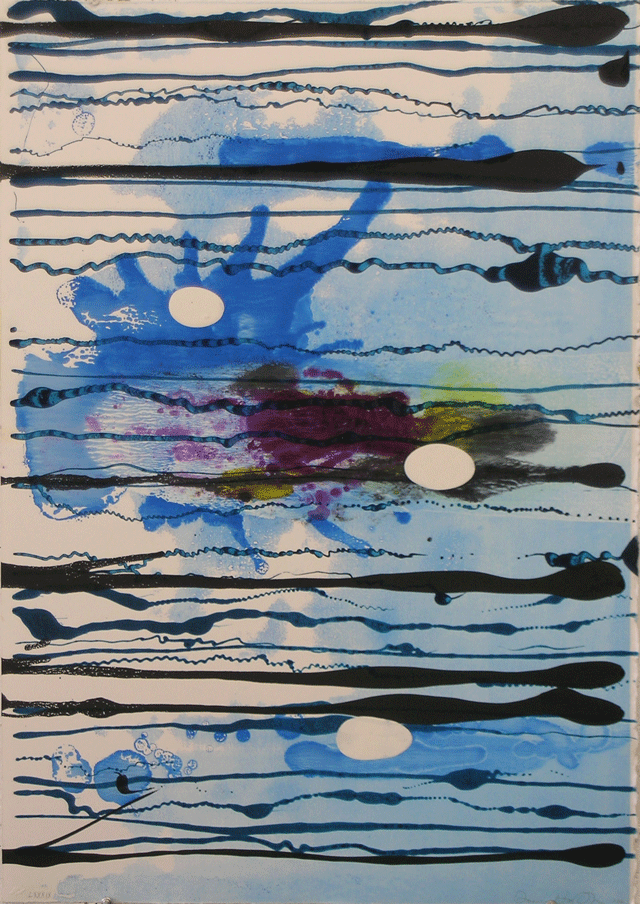
LXXXIX

LCVIII
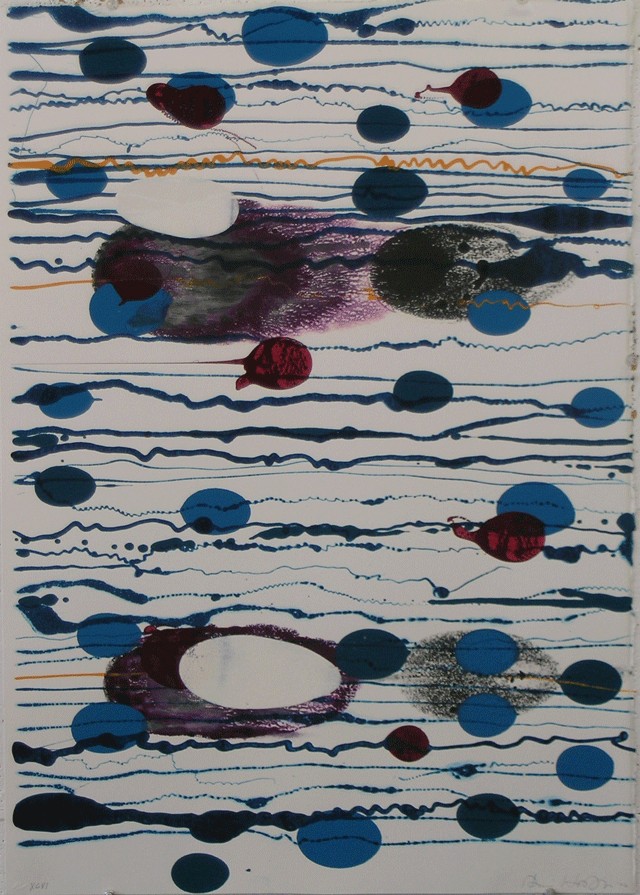
LCVI

LXIII

XXVII
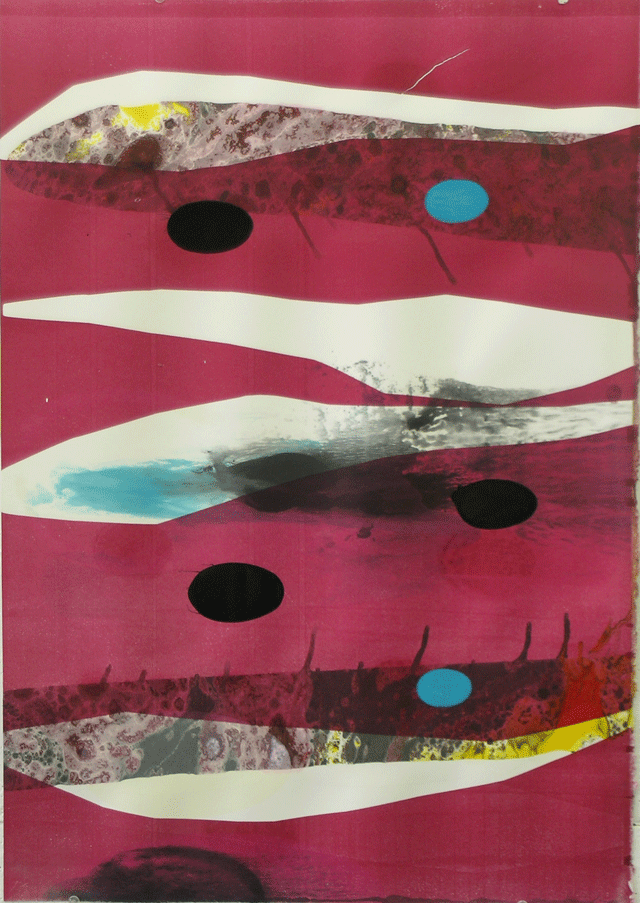
XXXII
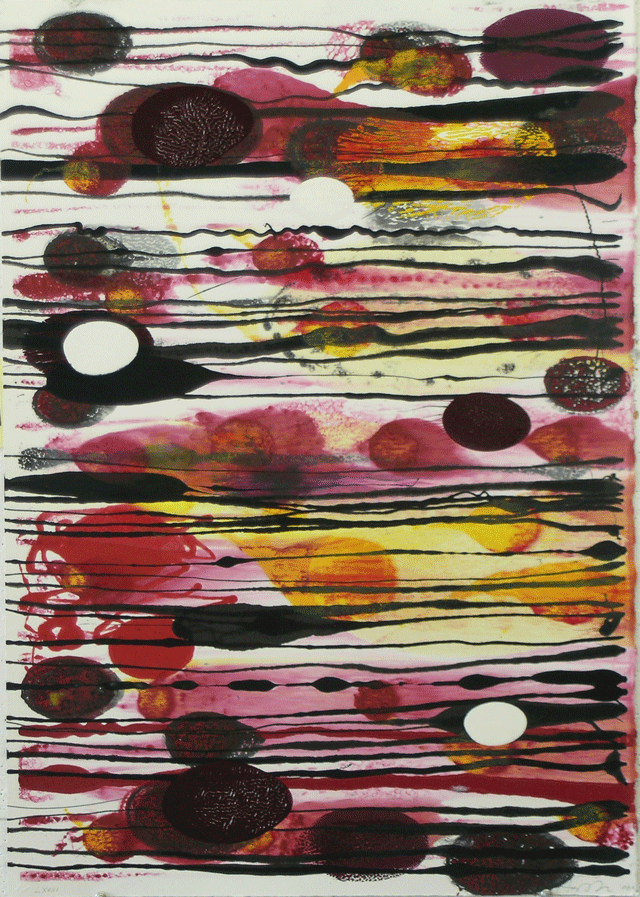
LXVIII
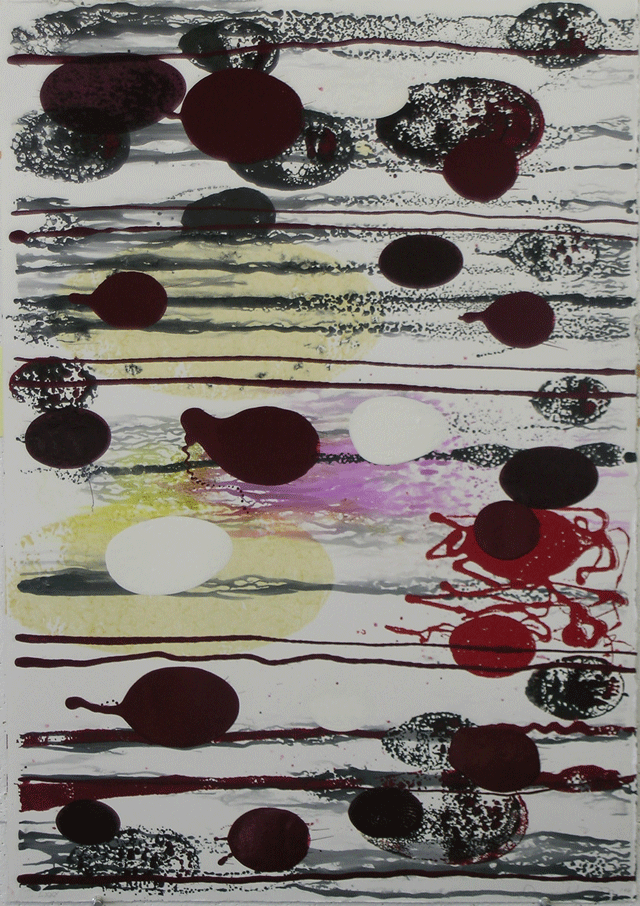
LXXX
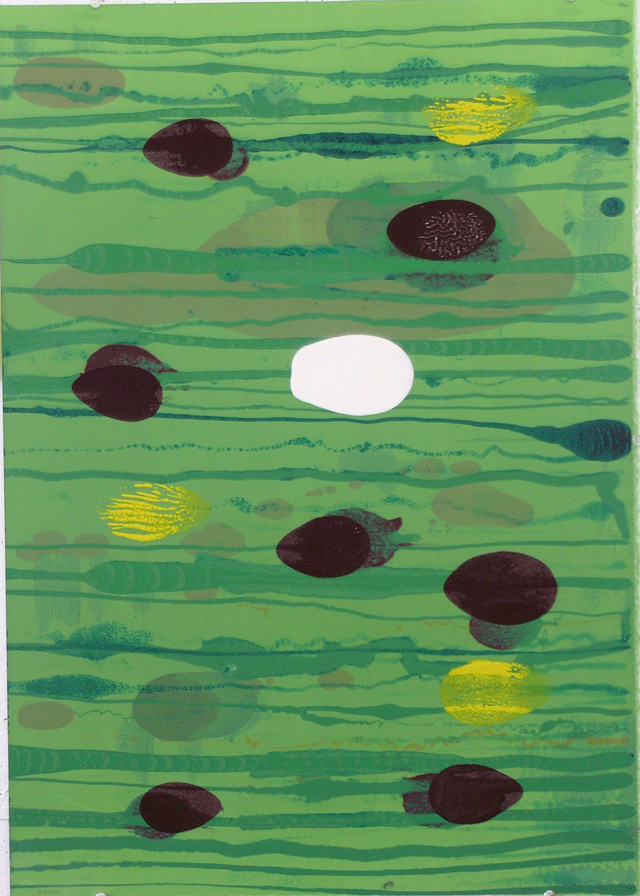
XLVIII
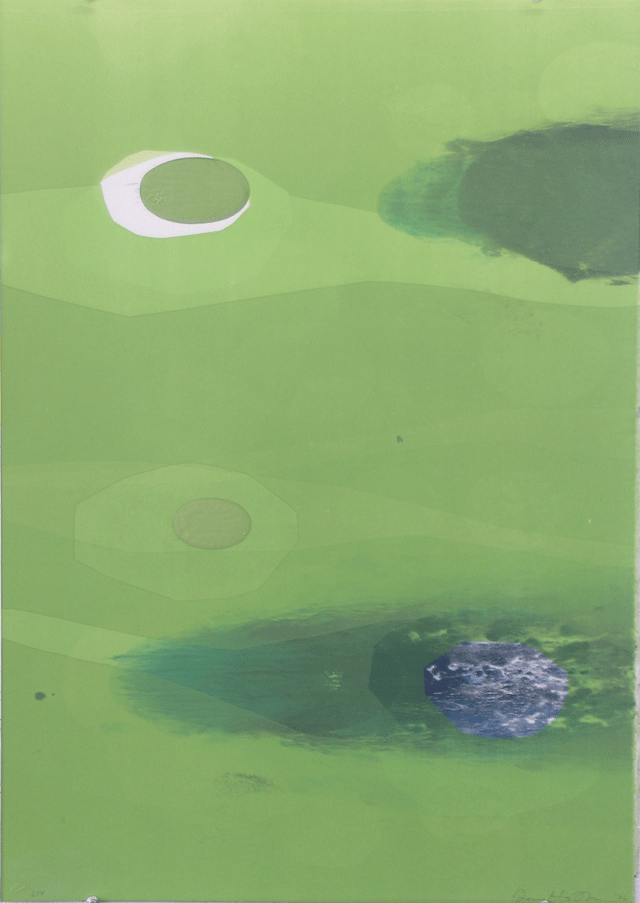
LIV
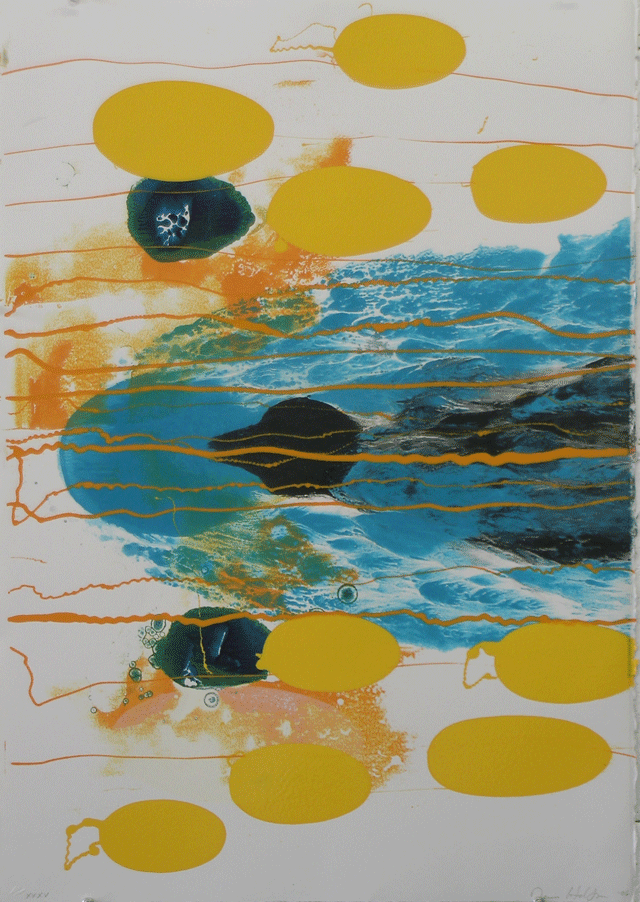
XXXV

XXXVIII
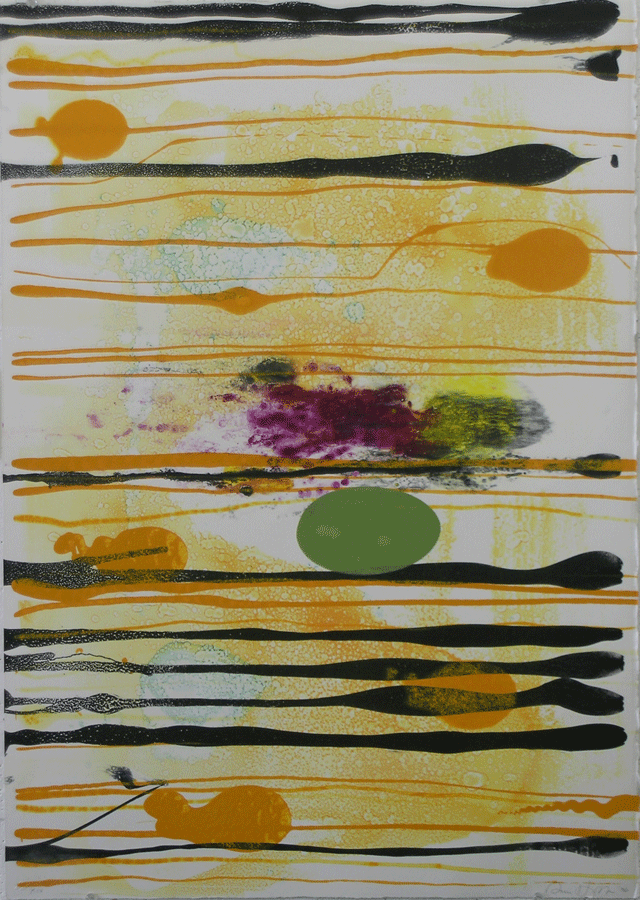
XIV
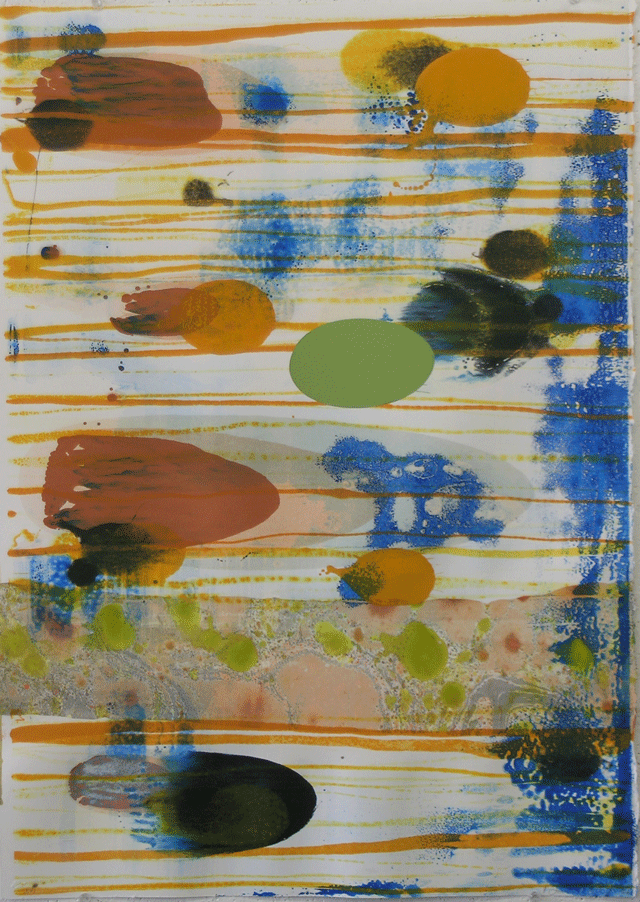
XVI
November 8, 2006
Medical Grade Enchilada Verdes

We have a general malaise around here. Everyone is feeling a bit funky. The guys at ChinaTown blame it on the Santa Ana winds, the dry desert winds that sweep towards the sea annually here in Southern California. Local artist Chris Lipomi (sculptor, shows at Dan Hug Gallery) attributes the corrosive effect to an excess of positive ions in the seasonal hot desert air. Apparently, negative ions come with splashy water, that's why we feel good around fountains and by the sea. But maybe there are multiple sources for these under-the-weather feelings? My wife Stephanie travels a lot and people around me in the art world tend to travel to art fairs and the like... maybe we are spreading contagion around a bit. She has a deep chest cold, a stubborn one. And I've just recieved an email from a friend in New York who is under the weather over there as well. There is something going on, everyone seems a bit down recently.
What to do?

Well, we recommend the medical grade enchilada verde plate at the classic neighborhood restaurant in Highland Park, el restaurante leyendario La Abeja. Devour the plate and it's off to bed with you, the perfect food coma. It will help cure what ails, almost as effective as a day at the beach.
November 7, 2006
Eras End and Begin Again
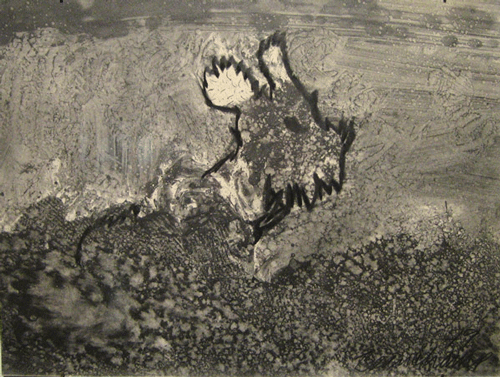
I've had a few thoughts that have been rattling around in my head recently, and I'm going to try to trot them out to see how they hang together. What is to come might be a bit raw... but this is a blog after all (a series of first drafts).
Aaron Parazette dropped a line to say hello and pass on some interesting reading. It was the introduction from Chris Anderson's "The Long Tail":
Hi D, back from SF--all went well, I'll fill you in when we talk (thanks for the props on the blog). Here's another essay--got it from Michelle Grabner the other day. Relevant for all us culture producers. AHere is a snip near the beginning of the introduction:
...This is the world the blockbuster built. The massive media and entertainment industries grew up over the past half century on the back of box-office rockets, gold records, and double-digit TV ratings. No surprise that hits have become the lens through which we observe our own culture. We define our age by our celebrities and mass-market products?they are the connective tissue of our common experience. The star-making system that Hollywood began eight decades ago has now spun out into every corner of commerce, from shoes to chefs. Our media is obsessed with what?s hot and what?s not. Hits, in short, rule. Yet look a little closer and you?ll see that this picture, which first emerged with the postwar broadcast era of radio and television, is now starting to tatter at the edges. Hits are starting to, gasp, rule less. Number one is still number one, but the sales that go with that are not what they once were...
And here are the concluding paragraphs: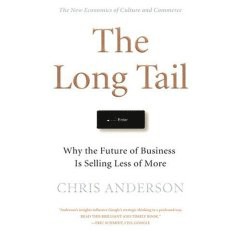
Seen broadly, it?s clear that the story of the Long Tail is really about the economics of abundance?what happens when the bottlenecks that stand between supply and demand in our culture start to disappear and everything becomes available to everyone.After listening to the Bad at Sports PodCasts (#'s 12, 19, 32 & 39) featuring Lane Reylea and Michele Grabner (check out the link, I highly recommend listening to the podcasts), I got the impression that both of these writers for ArtForum are simultaneously insiders and outsiders in the heart of the art industry* and that they have a palpable sense of the ground shifting beneath our feet. They both indicate a striking poverty of ideas and a universal lack of a sense of direction in the art world. Finally, Grabner advised a more careful scholarship to plot our way out of our late pomo Sargasso Sea and somewhat disturbingly yet tantalizingly, Reylea outright called for violent change (although I'm sure he meant it figuratively... I guess it's easy to smash the guitar against the amp since rock and roll never really dies).
People often ask me to name some product category that does not lend itself to Long Tail economics. My usual answer is that it would be in some undifferentiated commodity, where variety is not only absent but unwanted. Like, for instance, flour, which I remembered being sold in the supermarket in a big bag labeled ?Flour.? Then I happened to step inside our local Whole Foods grocery and realized how wrong I was: Today the grocery carries more than twenty different types of flour, ranging from such basics as whole wheat and organic varieties to exotics such as amaranth and blue cornmeal. There is, amazingly enough, already a Long Tail in flour.
Our growing affluence has allowed us to shift from being bargain shoppers buying branded (or even unbranded) commodities to becoming mini-connoisseurs, flexing our taste with a thousand little indulgences that set us apart from others. We now engage in a host of new consumer behaviors that are described with intentionally oxymoronic terms: ?massclusivity,? ?slivercasting,? ?mass customization.?
They all point in the same direction: more Long Tails.
After years of emulating the blockbuster effect in the promotion of careers in the art world, there is a sense that the phenomena of the eclipse of the superstar is occuring. Vectors of art power brokers which align on selected (and admitedly talented) artists, the sold out simultaneous solo shows, the lavish coffee table catalogs, the worldwide museum tours, the pride of place in the advertizing thickened magazines, the emulation by students and piggy backing by professors that promises to transmute power into prestige... it's all so tired now. Yes, we all want this for ourselves... but do we realy believe in it anymore?
For a parallel example in entertainment, I can point to the current Borat phenomena --a classic blockbuster engine cranking up to speed... but to me it seems creaky and ultimately lackluster. There was a moment at the end of summer when you could see everyone in the entertainment industry warily jumping on the bandwagon, no one wanting to be left out. Baron Sasha Cohen is definitely talented, funny more often than not, but dazzle today does not seem to be the way it was in the recent past. Television no longer has the authority it had in the three big primetime networks. Late night network comedy is no longer a force of habit. The newsprint media is a dead man walking, the New York Times is a hollowed out zombie. No one goes to libraries anymore, encyclopedias are curious relics --when they are not doorstops. Movies are being eclipsed by video games and reflexive MySpace personal account management. The audience is no longer captive.
Hence the rapt attention towards the dynamics of our info age paradigm shift.
I've been seeing a pattern in the phantasmagoria, the sermon is appearing in the suicide (see the colophon to the left for the reference). I've been noticing that the legacy artists that younger artists around me have been looking at are not only the rediscovered underdogs (as per Anderson's thesis) but that maybe the work of these underdogs share certain formal characteristics in common.
It's time to lay out a few examples:
The hardest part of this post was to figure out what to excerpt from Chris Jager's blogpost about nearly forgotten artist Robert Beauchamp. (The bunny-like image heads this post.) So I clipped the whole thing:I just saw the Beauchamp drawing show at the SMU Pollock Gallery ? truly weird and amazing. You may be thinking, ?who?? Here is a fragment of the introduction for the show:
?The American painter Robert Beauchamp (1923-1995) was one of the earliest and most well respected figurative painters to ermerge from the New York School of the late 50?s. Arriving on the scene a few years after Jackson Pollock, Beachamp (pronounced ?Bee-Chum?) choose to use figuration as he found abstraction unable to communicate the realities of the human condition as he saw them?prefiguring in many ways the renewed interest in the figure as subject matter in the late 80?s that persists even now?Beauchamp continued to work into his last weeks, even as he battled the cancer that ended his life. He died at home in New York City at the age of seventy one.?Philip Van Keuren, the curator, told me there were literally hundreds of these drawings, just from 1979, the drawings that populate this show. The drawing materials look like heaps of graphite powder, turpentine, and charcoal sticks on paper - but no one really knows for sure. Above is a strip of drawing from his ?Unicorn? series that he made after seeing the Cloisters Unicorn tapestries at the MET. Seeing similarities and making these intellectual connections is pure pleasure - and reminds me how art is more than just pure craft. Of course, as much as I like these drawings, I find his paintings hard to like. But actually, they remind me of the new insane aesthetic of chealsea figurative painting today. But it is rare that one sees anything this truly mysterious.
I Googled therefore:
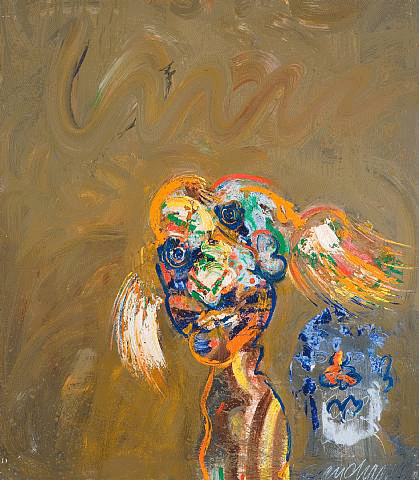
Yea, I can see what Chris means, but still, other artists are looking for something similar. For example, I was talking to Bart Exposito the other day. He was telling me of other artists that he's looking at: Pollock's neglected post drip re-figurations, other 30's era goofy surrealist figuration... a few others I cannot now recall. Then, during a visit to Bart's studio, I took a look at his copy of the Lee Bontecou MOCALA catalog co-authored by the incomparable curators Elisabeth A. Smith adn Robert Storr. I think I can see what Bart is looking for in Bontecou's ouevre.

Earlier I described a trend toward a celebration of the underdog, the overlooked artist. Now, I hope that I have trotted out enough evidence** to identify at least a formal interest in a kind of in-betweeness betwixt physical abstraction and figuration, a desire for a simultanaity of materiality and representation. It seems to be a search for the spark of the animate in the inanimate, acts of rendering that might be fully conscious -of our human history in making marks and of a respect for the limbic impulse to make them- to be simultaneously young and old, innocent and wise, a knucklehead and an impeccable professional.
Phil Wagner flagged me onto Ray Johnson's biography in the film How to Draw a Bunny" a year ago. Johnson, an artist who was one of those guys who fell by the wayside as the blockbuster engines roared past their lives. The ability to believe in yourself ...without self delusion... regardless if no one else does --that's the mark of an artist. Young artists watch this film with a grim resolve, I'm sure, like marines getting the tactical map briefing prior to D-Day. And artists definitely look to Johnson for models of commitment and for strategies for sustaining inspired creativity, Steve LaRose's postcard blog work for example.

The big question seems to be: are you still an artist when no one is looking?
***
So to wind up this meandering blogpost, I should end with the beginning of the train of thought, my reply to Aaron's email:
Aaron:It's good to hear that the show went well, muy bien. The gallery looks like a good one.
Cool excerpt. A few thoughts:
Somehow I don't think that our art world is yet exploiting the advantage of the long tail. Commerce seems to operate along the dynamics of the blockbuster era. Once we have people buying our stuff by seeing our work online, then we can say the art world is playing by the long tail rule.... but our art world seems to operate in terms of prestige: the bragging rights of collectors, the status of galleries, the ranking of artists... when will we we enjoy the spontaneous micro communities of fan-enthusiasts? But then the artworld was never a broadcast entity... it was always microcast... so maybe that answers my question.
Perhaps it's like this: our artworld grew explosively in our era ('86 - '06) and as such, it emulated mass entertainment, and maybe therefore our artworld emulated the blockbuster mentality too... but did it ever take hold? Maybe blockbuster worlds can grow a tail but you have to have a fully established blockbuster world in the first place... and even though I have said that we have a blockbuster mentality in our artworld, maybe it never has fully emerged before its eclipse? Or maybe the long tail for the art wold is there, but at this stage, it's a dotted line, a mere possibility, or yet too faint a line to see as clearly as that of music or movie industries. Or perhaps it's like this: the blockbuster model belongs to youth consumers (popular film and music) and scales of mass consumption. Once teens can desire and afford to collect art, then we can begin to grow a tail of our own.
One last minor thought: this tail is identical to the exponential curve describing technological change (Moore's Law) in our time. They call it "the Singularity".
-D
*An unfortunate word, but accurate for most people in it.
**Well, re-reading this... no, I haven't. By that paragraph, only two formal examples were offered, and a third implied by the reference to Ray Johnson. If you can trust me, there were other artist's names being dropped in conversation --now forgotten unfortunately-- that better delineated the trend I am trying to describe.
November 4, 2006
Joanne Greenbaum Opens in NYC
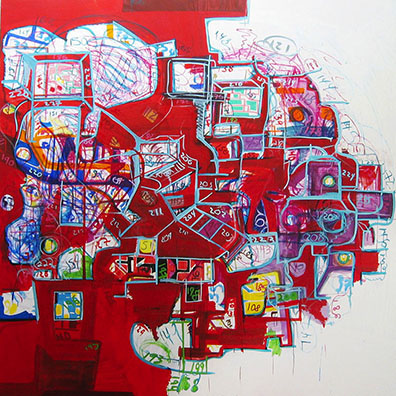
Joanne Greenbaum is opening tonight at D'Amelio & Terras and I wish I could be there!
Here's the blurb from the gallery:
D?Amelio Terras presents:JOANNE GREENBAUM: PAINTINGS
November 4 ? December 23, 2006
Opening Reception: November 4, 6-8pmD?Amelio Terras presents new paintings by gallery artist Joanne Greenbaum. Her recent canvases continue to be informed by her drawing practice but take a departure from a more formal and spare past work. Graphic formations that are broken up by painterly gestures allow different layers of meaning and visual readings to emerge. Combining multiple techniques and colors, Greenbaum explores the concept of gesture outside of its expressionistic trope. The paintings are surfaces on which to perform with paint, challenging the notion of ?doneness? and ?finishing?; this positioning is best manifested by the act of painting over or crossing off areas of the canvas. The system of numbers charts the chronological life of a painting and reinforces the self-referential process. She states: ?In fact I make painting by building? ? and with this body of work Greenbaum?s process is laid bare.
Michelle Grabner, in a review published in Flash Art, 2004 writes: ?Greenbaum pines for the vagaries within the most rudimentary elements of visual language, complicating them with intuitive and emotional impulses. The result is both familiar and original but consistently self-confident?.
Joanne Greenbaum shows in London, UK with greengrassi gallery and in Basel, Switzerland with Nicolas Krupp gallery. Greenbaum?s paintings will be included in The Triumph of Painting, Abstract America at The Saatchi Gallery, London, UK in 2007. In 2008 she will have a solo museum survey at Museum Abteiberg, Monchengladbach, Germany that will travel to Haus Konstruktiv, Zurich, Switzerland.
The painting above:
Workbook
2006
oil on canvas
78 x 78 inches
198.1 x 198.1 cm
November 3, 2006
Shoshana Epsilon
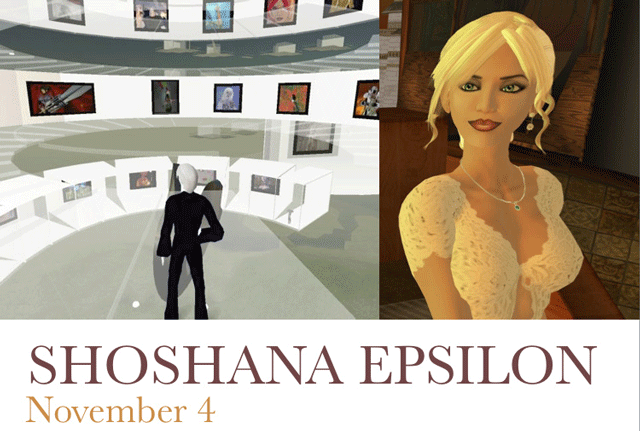
At first, I thought my friend Dean Terry recreated himself his avatar in Second Life as a cross between Laura Croft and Pamela Anderson.
Funny, conflicted feelings ensued.
Ah.... but then I realised that he is the Pied Piper for his students at UT Dallas (whew):
The First Major University Gallery Opens in Second LifeWant to go to a art opening in an online 3D world? The University of Texas at Dallas Arts & Technology (ATEC) Island in Second Life will host an opening of its new art gallery, The Metaverse Gallery and Performance Space. This is the first major art space developed by a university in Second Life, and it is all designed and built by ATEC and Computer Science graduate students in the Online Worlds Lab. The show features Shoshana Epsilon, an artist who takes photos in Second Life of avatars, 3D representations of people in the game-like world.
For this first show the curator, gallery designer, and UT Dallas graduate student Christi Nielsen chose to focus on an artist who makes her work exclusively within the online world, rather than importing work from outside. "Shoshana in some ways is very traditional: she is a portrait photographer - except she takes portraits of avatars" Nielsen said.
While this first show features still images, future shows will include interactive, participatory projects using a variety of approaches.
"One of the challenges of the emerging metaverse is to figure out just what you can do there, what conventions are emerging, and how much to bring from the physical world to the online world" says Dean Terry, the Online Worlds Lab director. "The focus of The Metaverse Gallery will be to exhibit work that uses the tools and dynamics of the metaverse space itself."
Then, I followed the SLURL in the link and documented my first visit to a virtual online art gallery:
It looks like I arrived too early for the opening.
Technical observations:
1.This whole adventure chewed up two hours this morning but who said a learning curve wouldn't have a price? It is interesting that in this time frame, I created a Second Life account, navigated to the UT Dallas virtual art gallery, checked out the show, documented the visit, added music to the video in iMovie (and opened that program up for the first time), uploaded the Quicktime video onto YouTube and then posted the whole thing on the blog.
Astounding.
2.After playing Counter-Strike so many years ago, Second Life would do better to study the movement, manipulation and communication controls in first person shooter desktop gaming.
3.I've read passing articles about how the nextgeneration web will be three dimensional. If this is true --and why not?-- then Dean's definitely on the right track here.
4. The cowboy twang floating in the druggy background is Brian Eno's "Deep Blue Sea", from the soundtrack in Trainspotting. Overtones of snorkeling. I had shot the video without thinking of the audio aspect , and it became mildly important to fill it in in iMovie by adding the soundtrack (I especially like the reality jolt at the end).
I thought it was multilevel kismet.
November 2, 2006
Aaron Parazette Opens in SF
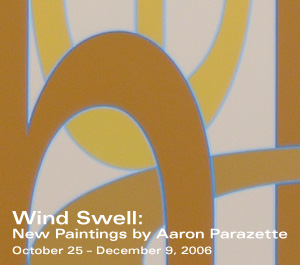
Here's a shout out to my good friend Aaron Parazette who is opening his show tonight in San Fransisco at Gregory Lind Gallery!
November 1, 2006
Dani Tull
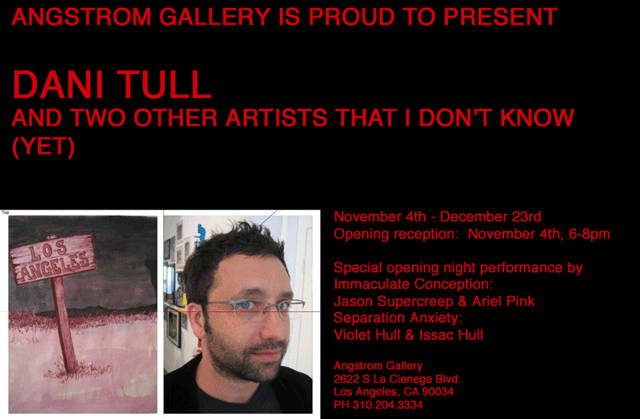
I intended to post something last spring about Dani Tull's opening at 4F Gallery at the north end of Chung King Road in ChinaTown, but I got overwhelmed by the flurry of events as I ramped up to fly to Spain to paint for the show in Barcelona. I felt bad that I missed the occasion to blog his show because it was a reemergence of one of the artists who used to show at the Kim Light Gallery, circa 1991 (the hot new gallery in town when I was pup)... that selfsame gallery where young gallerist Jeff Poe used to work behind the counter.
But what a nice coincidence that not only can I blog this show that will open this Saturday but that it is a gallery that I first encountered when Stephanie and I lived in Dallas a few years ago. I met David Quadrini the other day at Mandrake and I'm happy to report that he's looking great, very Californian. Dani and David are working together, supercool.
Here are a few pics that slipped away from my bloggy fingers last spring:
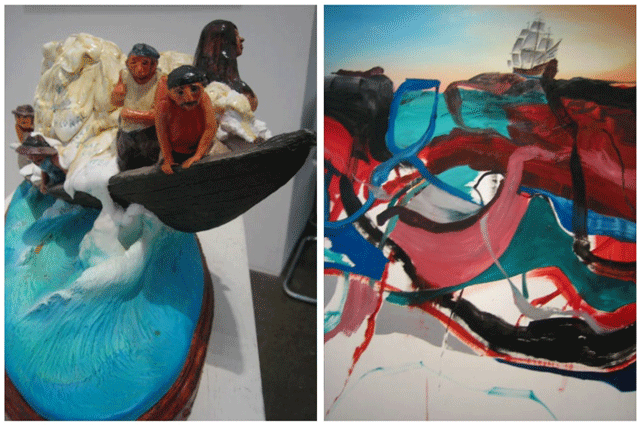

Here's the press release:
ANGSTROM GALLERY IS PROUD TO PRESENT:
Tami Demaree
I?ll Cross My Fingers but I Won?t Hold My Breath
Tanya Haden
Faces and Places and Things That Once Were
Dani Tull
Mersh and Myth
Tami Demaree, Untitled, 2006, watercolor on vintage print, 10 3/4 x 13 inches
November 4th ? December 23rd
Opening reception: November 4th, 6 ? 8 pm
Special opening night performance by
Immaculate Conception: Jason Supercreep & Ariel Pink
Separation Anxiety: Violet Hull & Issac Hull
Angstrom Gallery is proud to present three solo exhibits of local artists Tami Demaree, Tanya Haden, and Dani Tull.
A reception for the artists will be held on November 4th, from 6 ? 9 pm.
In the main gallery, Angstrom Gallery is proud to present Tami Demaree. Born in 1978 in Huntington Beach, CA, Demaree is mixed media artist whose collages, paintings and sculptures mix mythical imagery and cultural references with an exuberant Do It Yourself sensibility, while wolf-headed women and pink dolphins taunt nine-headed snakes under a waterfall of cut-paper tears. Painted rainbows frame love and loss and felt pendants spout sweet nothings. Demaree?s world is distinguished by a sentiment perfectly calibrated to both honor and satirize the overwrought musings of an American girl. Demaree's installations form an entertaining and bewildering space in which pop songs and tear-jerk movies invade and maybe displace the sanctity of the private emotional world. This will be her debut solo exhibition.
In the second gallery, Angstrom Gallery will present Los Angeles based artist Tanya Haden. Haden primarily works with pencil and ink. Her background as an animator lends to the creation of narrative drawings that explore childhood memories, fears and the boundaries in familial relationship. She often employs humor that skillfully represents the fragility and power of innocence, innocence lost, and general power structures in all aspects of life.
In the third gallery, Angstrom Gallery will present Los Angeles artist Dani Tull. Tull has exhibited internationally and locally with Blum and Poe. His most recent exhibition in Los Angeles ?Odd Arc? was heralded by Doug Harvey in the LA WEEKLY as ?one of the most complex and entertaining gallery shows in recent memory?, and ?the missing link between Mike Kelley?s and Jim Shaw?s curdled Pop and that of the emerging Los Angeles neo-psychedelic school.? For his show with Angstrom Gallery, Dani Tull will show a series of paintings that mine the rich complexities of painting in contemporary times. His approach allows for equal footing between abstraction and the representational, as iconic imagery stratify both personal and pop mythologies.
For additional information please contact Genevieve Pepin 310.204.3334.

